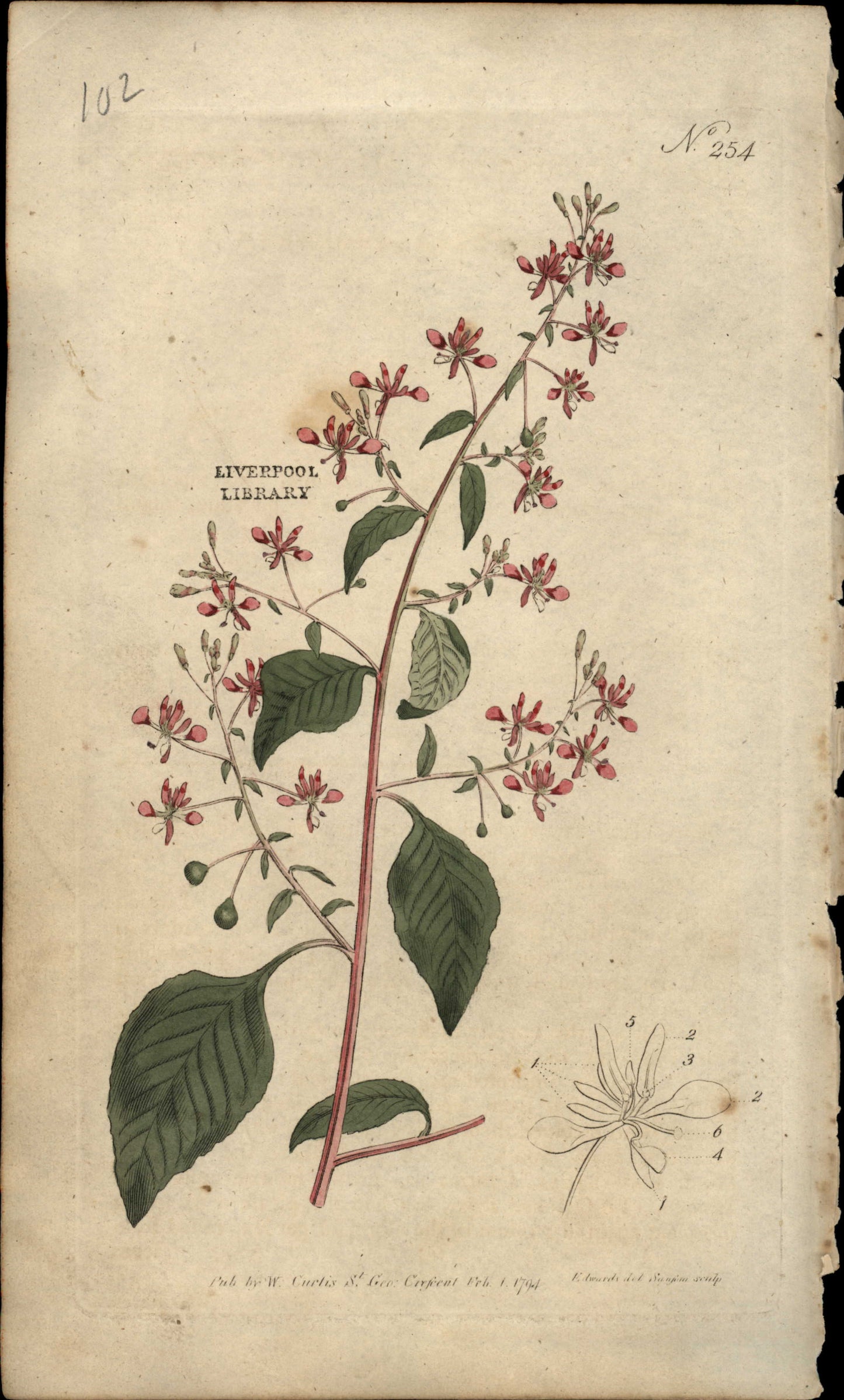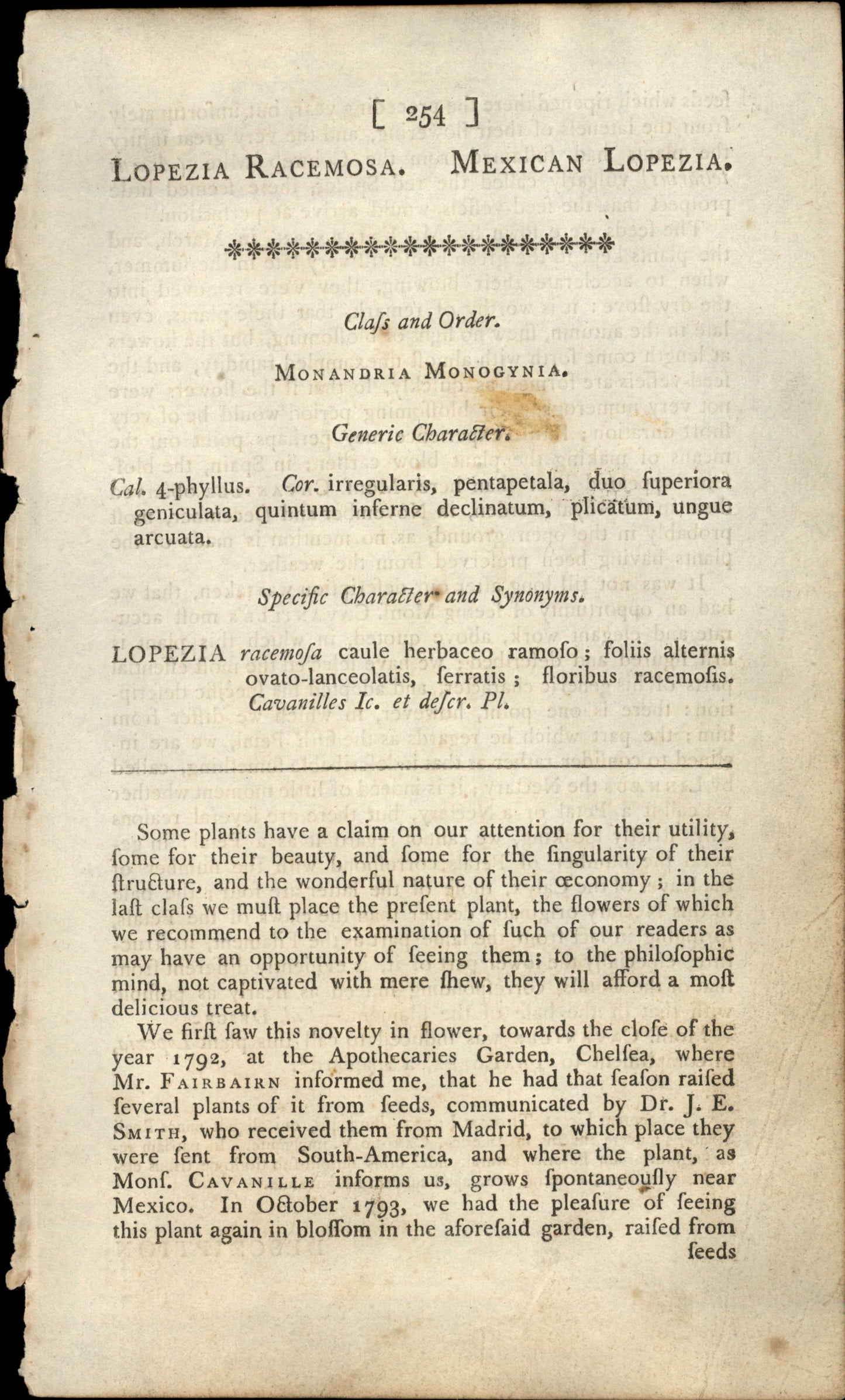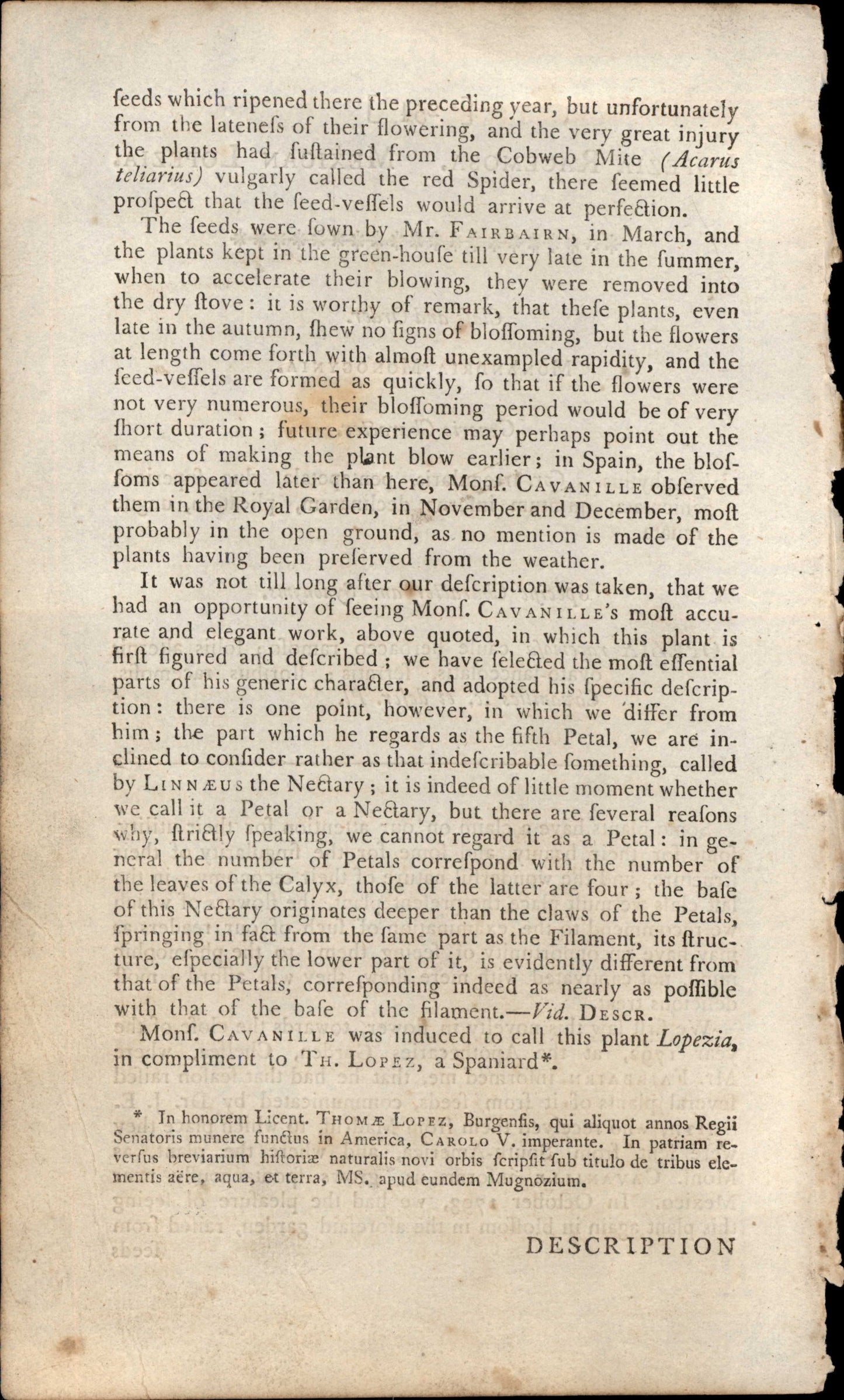Curtis Botanical Magazine
Plate 254 - Lopezia Racemosa
Plate 254 - Lopezia Racemosa
Couldn't load pickup availability
Plate 254
Flowering Period: May - October
Publication Date: Feb 1 1794
Description:
Complete Botanical Text (Cleaned)
254 Lopezia Racemosa - Mexican Lopezia orlw Class and Order od bas biMONANDRIA MONOGYNIA stow is twoll Generic Character Told Cal 4-phyllus Cor irregularis pentapetala duo superiora geniculata quintum inferne declinatum plicatum ungue of an bnuoro Ite dadoiq arcuata swish specific Character and synonyms Tow ived amely 140 de bed 1206 flom Lopezia racemofa caule herbaceo ramoso soliis alternis ovato-lanceolatis ferratis floribus racemofis Cavanilles Ic et defcr Pl doidw sq su Some plants have a claim on our attention sor their utility some sor their beauty and some sor the singularisty of their ftructure and the wonderful nature of their economy in the last class we must place the present plant the flowers of which we recommend to the examination of such of our readers as may have an opportunity of feeing them to the philosophic mind not captivated with mere shew they will afsord a most delicious treat We first saw this novelty in flower towards the close of the year 1792 at the Apothecaries Garden Chelsea where Mr Fairbairn informed me that he had that feason raised several plants of it from seeds communicated by Dr J E sMITH who received them from Madrid to which place they were sent from South-America and where the plant as Monf Cavanille informs us grows spontaneously near Mexico In October 1793 we had the pleasure of feeing this plant again in blofsom in the asoresaid garden raised from seeds seeds which ripened there the preceding year but unsortunately from the latenefs of their flowering and the very great injury the plants had fustained from the Cobweb Mite Acarus teliarius vulgarly called the red spider there seemed little prospect that the seed-vessels would arrive at perfection The seeds were sown by Mr Fairbairn in March and the plants kept in the green-houfe till very late in the summer when to accelerate their blowing they were removed into the dry stove it is worthy of remark that these plants even late in the autumn shew no figns of blofsoming but the flowers at length come sorth with almost unexampled rapidity and the seed-vessels are formed as quickly so that if the flowers were not very numerous their blofsoming period would be of very short duration future experience may perhaps point out the means of making the plant blow earlier in spain the blof soms appeared later than here Monf Cavanille observed them in the Royal Garden in November and December most probably in the open ground as no mention is made of the plants having been preserved from the weather It was not till long after our description was taken that we had an opportunity of feeing Monf Cavanille'S most accu rate and elegant work above quoted in which this plant is first figured and described we have felected the most efsential parts of his generic character and adopted his specific defcrip tion there is one point however in which we differ from him the part which he regards as the fifth Petal we are in clined to consider rather as that indefcribable something called by Linneus the Nectary it is indeed of little moment whether we call it a Petal or a Nectary but there are several reasons why strictly speaking we cannot regard it as a Petal in ge neral the number of Petals correspond with the number of the leaves of the Calyx those of the latter are sour the base of this Nectary originates deeper than the claws of the Petals springing in fact from the same part as the Filament its ftruc ture especially the lower part of it is evidently different from that of the Petals corresponding indeed as nearly as poffible with that of the base of the filament.-Vid DEsCR Monf Cavanille was induced to call this plant Lopezia in compliment to TH Lopez a spaniard bolist tolko 60 21 moil ai de In honorem Licent Thome Lopez Burgenfis qui aliquot annos Regii Senatoris munere sunctus in America Carolo V imperante In patriam re verfus breviarium naturalis novi orbis fcripfit fub titulo de tribus ele mentis aqua et terra MS apud eundem Mugnozium guigalla amisole adi bad to boli beg histols oth afli ni moll old at niste Jus absol DEsCRIPTION
Liverpool Library Edwards del Sanja sculp Pub by W Curtis S Geo Crefcent Feb 1 1794
Raw OCR Text (Original)
visinom jud 254 Lopezia Racemosa bus 54 Mexican Lopezia orlw Class and Order od bas biMONANDRIA MONOGYNIA stow is twoll Generic Character Told Cal 4-phyllus Cor irregularis pentapetala duo superiora geniculata quintum inferne declinatum plicatum ungue of an bnuoro Ite dadoiq arcuata swish specific Character and synonyms Tow ived amely 140 de bed 1206 flom Lopezia racemofa caule herbaceo ramoso soliis alternis ovato-lanceolatis ferratis floribus racemofis Cavanilles Ic et defcr Pl doidw sq su Some plants have a claim on our attention sor their utility some sor their beauty and some sor the singularisty of their ftructure and the wonderful nature of their economy in the last class we must place the present plant the flowers of which we recommend to the examination of such of our readers as may have an opportunity of feeing them to the philosophic mind not captivated with mere shew they will afsord a most delicious treat We first saw this novelty in flower towards the close of the year 1792 at the Apothecaries Garden Chelsea where Mr Fairbairn informed me that he had that feason raised several plants of it from seeds communicated by Dr J E sMITH who received them from Madrid to which place they were sent from South-America and where the plant as Monf Cavanille informs us grows spontaneously near Mexico In October 1793 we had the pleasure of feeing this plant again in blofsom in the asoresaid garden raised from seeds 102 N 254 Liverpool Library 5 2 3 2 6 4 Edwards del Sanja sculp Pub by W Curtis S Geo Crefcent Feb 1 1794 seeds which ripened there the preceding year but unsortunately from the latenefs of their flowering and the very great injury the plants had fustained from the Cobweb Mite Acarus teliarius vulgarly called the red spider there seemed little prospect that the seed-vessels would arrive at perfection The seeds were sown by Mr Fairbairn in March and the plants kept in the green-houfe till very late in the summer when to accelerate their blowing they were removed into the dry stove it is worthy of remark that these plants even late in the autumn shew no figns of blofsoming but the flowers at length come sorth with almost unexampled rapidity and the seed-vessels are formed as quickly so that if the flowers were not very numerous their blofsoming period would be of very short duration future experience may perhaps point out the means of making the plant blow earlier in spain the blof soms appeared later than here Monf Cavanille observed them in the Royal Garden in November and December most probably in the open ground as no mention is made of the plants having been preserved from the weather It was not till long after our description was taken that we had an opportunity of feeing Monf Cavanille'S most accu rate and elegant work above quoted in which this plant is first figured and described we have felected the most efsential parts of his generic character and adopted his specific defcrip tion there is one point however in which we differ from him the part which he regards as the fifth Petal we are in clined to consider rather as that indefcribable something called by Linneus the Nectary it is indeed of little moment whether we call it a Petal or a Nectary but there are several reasons why strictly speaking we cannot regard it as a Petal in ge neral the number of Petals correspond with the number of the leaves of the Calyx those of the latter are sour the base of this Nectary originates deeper than the claws of the Petals springing in fact from the same part as the Filament its ftruc ture especially the lower part of it is evidently different from that of the Petals corresponding indeed as nearly as poffible with that of the base of the filament.-Vid DEsCR Monf Cavanille was induced to call this plant Lopezia in compliment to TH Lopez a spaniard bolist tolko 60 21 moil ai de In honorem Licent Thome Lopez Burgenfis qui aliquot annos Regii Senatoris munere sunctus in America Carolo V imperante In patriam re verfus breviarium naturalis novi orbis fcripfit fub titulo de tribus ele mentis aqua et terra MS apud eundem Mugnozium guigalla amisole adi bad to boli beg histols oth afli ni moll old at niste Jus absol DEsCRIPTION
Original botanical print from Curtis's Botanical Magazine
Share







